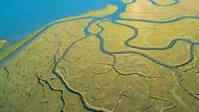Chapter 8 (aquatic biodiversity)
1/31
There's no tags or description
Looks like no tags are added yet.
Name | Mastery | Learn | Test | Matching | Spaced |
|---|
No study sessions yet.
32 Terms
polyps
colonies that make up the coral reefs
secrete calcium carbonate
symbiotic relationship with algae
Zooxanthellae
(single celled algae) provide food to the coral which results in photosynthesis
overturns
caused by seasons (spring and fall)
equalizes temp in water
O2 sent to bottom - nutrients sent to top
during summer and winter- more divide and layers
in temperate lakes
phytoplankton
plant (single celled plants or bacteria) algae
zooplankton
animal (jellyfish) ones that drift with water
ultraplankton
small free drifting organisms (includes zooplankton and phytoplankton)
Nekton
able to swim against currents fish/ turtles/ whales
benthos
bottom dwellers
ocean acidification
costal zone
warm
nutrient rich
shallow water
<10 % of ocean
> 90% of marine life
open sea
cold
not as much nutrients
deep
> 90% of ocean
<10 % of marine life
Mangroves
a group of trees and shrubs that live in the coastal intertidal zone
place for fish to hide
absorbs CO2
produces O2
slows coastal erosion
habitat for birds
Watershed
an area of land that drains all the streams and rainfall to a common outlet
oligotrophic lakes
poorly nourished
newly formed
rocky bottom
steep sides
clear
eutrophic lakes
well nourished
excessive plant growth
algae
shallow/ sandy (less rocks)
gentle slope
mesotrophic lake
having a moderate amount of dissolved nutrients
cultural eutrophication
humans input on nutrients (acceleration process)

estuary
mix of fresh and saltwater (salt marshes or mangrove trees) the tidal mouth of a large river, where the tide meets the stream
intertidal zone
between high and low tide
changing temp
changing salinity
wave action
desiccation
barrier island
stop erosion and protect shores
euphotic zone
light
sunlight penetrates
low nutrients
high photosynthesis - high O2
bathyal zone
some light
little dark
abyssal zone
low temp
low O2 - low photosynthesis
high pressure
high nutrients
blind animals
source (river)
fastest water
at top
cold temp - high oxygen
clear (turgid)
transition (river)
quick water
picks up some sediments and nutrients
food plain (river)
sediment deposited
flat
fertile and nutrient rich
flows into ocean
warmest water - (low O2?)
turbid
littoral (lake)
near shore
shallow
plants
light
high biodiversity
limnetic (lake)
not near shore
top layer
light
profundal (lake)
darker
lower biodiversity
benthic
bottom level
decomposers
percent competition
pop of organism/ total pop
EPT/ midge
ept- intolerant species in water (mayflies, stoneflies, caddisflies)
high ratio - better quality